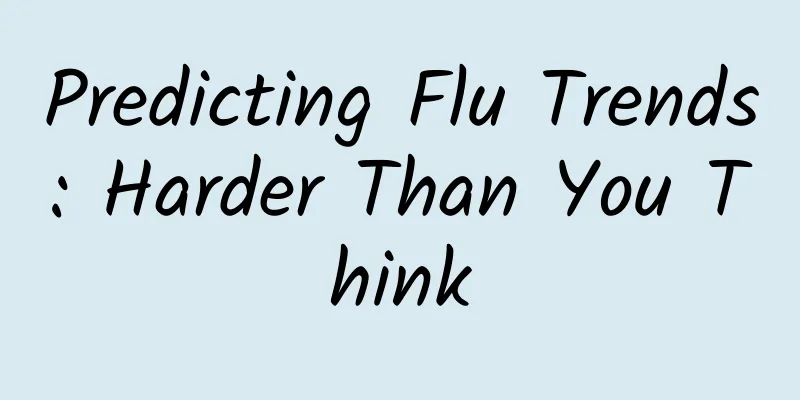Predicting Flu Trends: Harder Than You Think

|
Even if you were given a forecast now about the trend of respiratory diseases in the coming weeks, it would not be worth trusting. Written by Li Changqing (Doctor of Medicine, practicing physician in the United States) Every autumn and winter, respiratory clinics and wards are busy, especially pediatric clinics and wards. A large number of children with fever and cough fill pediatric wards, consulting rooms and corridors, making parents, children and medical staff miserable. As the first flu season after the COVID-19 epidemic prevention measures were relaxed, the situation this year is particularly serious. In addition to suffering, people want to know the answer to a question: How long will this trend last and when will it end? Flu season will eventually end, as will other respiratory disease outbreaks. But such answers are clearly unsatisfactory. People need to know the specific situation in the next week and the next month, including whether the number of patients with respiratory diseases will increase or decrease, by what magnitude, and how the situation will differ in each place. Not only do ordinary people care about these questions, but the answers are also particularly important for public health departments, which can help rationally allocate and supplement resources and take necessary epidemic prevention measures. For this reason, predicting trends in influenza and other seasonal epidemics has always been a hot topic in the public health profession. Take influenza as an example. Traditional predictions are based on past experience, summarizing the influenza situation in various places at a certain time each year in the past to predict the influenza epidemic this year or even a few years later. However, the influenza epidemic situation is different every year because this complex trend is affected by many factors. A slight change in one or several factors may lead to a huge trend difference. These factors include virus factors, vaccination status, seasonality, population (and mobility) factors, etc. Such a complex system cannot be predicted by simple data comparison, and needs to be analyzed with the help of complex mathematical models. Even with mathematical models, a large amount of accurate information needs to be input to make predictions, including the trend of outpatient visits for influenza-like patients in various regions, the positive detection of influenza virus in respiratory specimens, and the hospitalization of influenza-like patients. After the rise of the Internet, researchers came up with the idea of using social media and online searches to predict the prevalence of influenza. As early as 2013, the Centers for Disease Control and Prevention (CDC) in the United States launched an annual flu forecasting challenge, inviting technically qualified institutions to predict the prevalence of influenza in 1-4 weeks by analyzing online information. This year is the tenth year of this activity. As of November 27, a total of 22 teams have made 27 model predictions. Except for a few models, most models predict that flu cases and hospitalizations will continue to increase across the United States until December 9. The predictions of different models vary greatly: the number of daily case reports ranges from the current 4,000 to 2,900 to 10,000. The CDC summarizes a general trend based on these models. But even this summary trend may not be necessarily accurate. It is clear that even in regions and countries with relatively comprehensive data monitoring, it is quite difficult to accurately predict the trend of influenza. In view of this, it is probably difficult to predict the situation in China in the next few weeks. Especially considering that the pathogens prevalent this season are far more than just influenza viruses, there are also other pathogens such as rhinoviruses and respiratory syncytial viruses. Based on the existing information, it is not realistic to accurately predict the prevalence of respiratory diseases in the next few weeks. Even if someone guesses correctly, it is likely a guess, and it may not be correct next time. Even if a model that can accurately predict future trends emerges, it needs to input accurate and comprehensive epidemiological data to make predictions; prediction models based on social media and network information also need to be verified in different network environments. Ultimately, everything starts with improving public health infrastructure. This article is supported by the Science Popularization China Starry Sky Project Produced by: China Association for Science and Technology Department of Science Popularization Producer: China Science and Technology Press Co., Ltd., Beijing Zhongke Xinghe Culture Media Co., Ltd. |
<<: Uncovering the gems of our table: the nutritious and versatile legume family
Recommend
Stop it! Frequent eye rubbing may induce this eye disease, which can cause blindness in severe cases!
"My eyes are tired, itchy, or uncomfortable....
The correct way to take acetate methyl to induce menstruation
Every female friend has a menstrual period every ...
One line for seven days of delayed menstruation
We all know that if a woman becomes pregnant, the...
Why do women have pain on both sides of their lower abdomen?
Lower abdominal pain may be a very common symptom...
What happens if I take emergency contraceptive pills without getting pregnant?
Many women do not plan to have children for the t...
Can I get an IUD if I have a cough?
In life, many couples will take preventive measur...
Why does a convex lens converge light? Do plano-convex lenses have two focal points?
Myopia glasses are glasses that are used to corre...
Where are the most crowded places in Sanya? Which district in Sanya is the most prosperous?
Sanya has many good tropical fruits and unforgett...
What are the effects of fallopian tube removal on the body?
Having a baby is a dream for every woman. If you ...
Thick, sticky discharge during ovulation
What should I do if my lower body secretes a thic...
How to remove cesarean section scars
Women have to go through the process of pregnancy...
What is the oval flesh on the female genitals?
The female genitals and male genitals are complet...
What gifts are good for early pregnancy?
Giving gifts between good friends is a very commo...
What are the changes in body temperature during ovulation?
During the ovulation period, women's body tem...
Are there other ways to test for pregnancy besides pregnancy test sticks?
Pregnancy is a special feeling. For a woman, preg...









